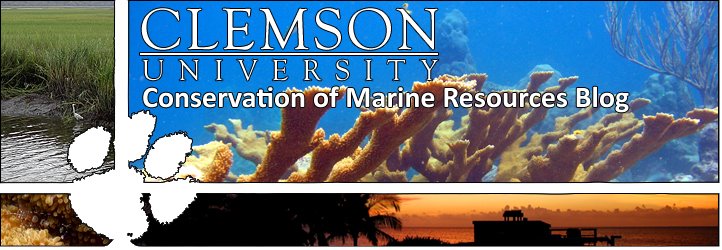 |
Scott Miller completed his Calhoun Honors College BS Thesis
Katherine Heldt completed her Biological Sciences MS Thesis |
Effects of disease and ocean acidification on the den
sharing behavior of juvenile Caribbean spiny lobster, Panulirus argus
Scott Donald Miller
Calhoun Honors Undergraduate Thesis
Department of Biological Sciences
Clemson University
Dr. Michael Childress
Thesis Advisor
Abstract
Chemical cues play important roles throughout marine
ecosystems, and different factors can alter the way that organisms detect or
interpret these cues. Diseases in
populations and global water quality changes, such as ocean acidification, can
greatly alter the behavior associated with information gathered from
olfaction. The Caribbean spiny lobster,
Panulirus argus, is an organism that relies on chemical cues to find protective
shelters and to mediate social behavior, and both disease and ocean acidification
have the potential to impact its ability to rely on these cues for these
behaviors. Our study sought to see how
disease would influence lobsters’ ability to compete for shelters and how ocean
acidification impacts den sharing and social behavior in these lobsters. This study comprised of three parts.
The first portion of the study examined the interactions
between diseased and healthy lobsters in a shelter-limited environment. A healthy lobster was placed inside of the
only den in an experimental aquarium, a diseased lobster was introduced, and
physical interactions were observed.
This was repeated with the same lobster inside the den, but with a
healthy lobster as the intruder. We
found that the presence of a diseased lobster lowered the aggression of both
healthy and diseased lobsters and that in diseased trials, the healthy lobster
spent more time in the den compared to the diseased individual.
In the second part of the study, the effects of ocean
acidification on lobsters’ den sharing and aggressive behavior were
examined. Lobsters were housed in pairs
and observed nightly for a week in both normal and lowered pH, where aggressive
acts, den sharing, and olfactory sampling behaviors were measured. Y-maze odor preference trials were run
simultaneously to determine lobsters’ odor preferences. The Y-maze trials were conducted in three
rounds. During the first round, lobsters
were kept in normal pH water and the Y-maze contained normal pH water. In the second round, home aquaria were kept
the same, but the Y-maze contained lowered pH water. For the third round, both home aquaria and
the Y-maze pH were lowered. During
behavioral observations, we found lobsters to show less aggressive acts, less
den sharing, less antennule flicks, and more antennule wipes after prolonged
exposure to depressed pH. Lobsters
showed some evidence of altered odor preference when the Y-maze pH was reduced.
In the final portion of the study, scanning electron
microscopy was used to determine if exposure to pH damages the sensory organs
of the lobsters. At the completion of
the study, lobsters’ antennules were removed, fixed, and observed under
SEM. We found similar counts of setae in
both groups. There was evidence of
damage in the group exposed to lower pH, but due to a small sample size, this
was inconclusive. This study provides
evidence for significantly altered den sharing and social behavior in P. argus
when exposed to various stressors that are projected to continue to be an issue
in the future.
Individual behavioral variation of juvenile spiny lobster (Panulirus argus) denning behaviors and
the role it plays in shelter competition during habitat loss
A Thesis Presented to the Graduate School of Clemson
University
In Partial Fulfillment of the Requirements for the Degree Master
of Science In Biological Sciences
Katherine A Heldt
Michael J. Childress, Committee Chair
Abstract
Variation in juvenile spiny lobster (Panulirus argus) aggressive and gregarious behaviors may play an
important role in structuring population level interactions. Since aggressive and gregarious behaviors
were not repeatable and were found to be highly correlated with size, these
behaviors were found to be largely driven by a combination of behavioral
plasticity and ontogeny. Although larger
individuals were found to be the most aggressive individuals, least gregarious
and often occupied crevice shelters by themselves, they did not exclude
smaller, less aggressive lobsters from crevice shelters. Surprisingly, in shelter limited situations,
small, less aggressive individuals were more likely to use dens and remain in
dens, while large, more aggressive individuals were more likely to remain
outside of dens and disperse. In
general, larger individuals are able to walk longer distances in less time and
are less likely to be preyed upon while away from shelter, suggesting that
vulnerability may play an important role in the decision to share dens or
disperse. Effects of prior experiences
in natural shelter-rich or natural shelter-poor habitats were also found to
influence denning behaviors with individuals from natural shelter-poor habitats
better responding to sudden shelter loss. Therefore, prior experiences may also
play an important role in denning behavior.
This thesis provides evidence for behavioral ontogeny and plasticity in
juvenile spiny lobster social behavior and is an important first step in understanding
the role of individual behavioral variation in den competition and behavioral
mitigation of habitat loss.























